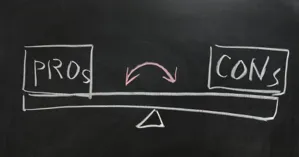- Quick Summary
- What is Affiliate Marketing?
- How Affiliate Marketing Works
- Choosing the Right Affiliate Program
- Finding the Right Affiliate Products
- Online Affiliate Marketing
- Track and Analyze Results
- Build Relationships with Your Audience
- Affiliate Marketing Pros
- Affiliate Marketing Cons
- Common Mistakes to Avoid
- Conclusion

- Quick Summary
- What is Affiliate Marketing?
- How Affiliate Marketing Works
- Choosing the Right Affiliate Program
- Finding the Right Affiliate Products
- Online Affiliate Marketing
- Track and Analyze Results
- Build Relationships with Your Audience
- Affiliate Marketing Pros
- Affiliate Marketing Cons
- Common Mistakes to Avoid
- Conclusion
Passive income gives you an income stream without the need for constant attention. You set it and forget. One of the best forms of passive income is affiliate marketing. It’s simple and east to set up. But how do you start a passive income stream with affiliate marketing.
What is Affiliate Marketing?

In a nutshell, affiliate marketing is when you earn a commission for promoting another company or person’s product.
When you promote that company and the customer buys their product, you receive a cut of the sale.
You’re not spending time or money creating your own products; you’re selling or at least promoting something that’s already in place.
But you do have to start the ball rolling, by letting your fans or audience know about the product. That could take some amount of work. But once you have it in place, it runs by itself.
Understanding how affiliate marketing work involves knowing the mechanics and processes, such as using unique affiliate links to promote products and earning income through commissions.
How Affiliate Marketing Works

Many companies offer affiliate marketing programs. They sometimes refer to their affiliates (you) as partners. Amazon is a good example of a company that provides these types of partnerships, but they refer to their affiliates as associates. Etsy also has an affiliate program.
Many firms have developed their own affiliate programs to manage their affiliate relationships directly, avoiding the constraints and fees associated with networks, while tailoring their programs to fit their specific audience and niche.
Amazon or Etsy will provide you with a unique link to a product you want to promote. When the potential customer clicks on that link, then they’re taken directly to the product. If the customer buys the product, you’ll receive a percentage of the sale price.
Choosing the Right Affiliate Program

Choosing the right affiliate program is crucial for successful affiliate marketing. With so many programs available, it can be overwhelming to decide which one to join. Here are some factors to consider when selecting an affiliate program:
-
Relevance: Choose a program that aligns with your niche and target audience. For instance, if you run a fitness blog, an affiliate program that sells gym equipment or health supplements would be a perfect fit. This ensures that the products you promote are of genuine interest to your readers.
-
Commission Rate: Look for programs that offer competitive commission rates. Higher commission rates mean more earnings per sale, which can significantly boost your passive income. Compare different programs to find the best rates available.
-
Cookie Duration: Consider programs with longer cookie durations. A cookie duration is the time frame in which you can earn a commission after a potential customer clicks your affiliate link. Longer durations increase your chances of earning commissions, even if the customer doesn’t make an immediate purchase.
-
Tracking and Reporting: Ensure the program provides reliable tracking and reporting tools. These tools help you monitor your performance, understand which strategies are working, and make data-driven decisions to optimize your affiliate marketing efforts.
-
Support: Look for programs with dedicated support teams. Having access to a responsive support team can be invaluable, especially when you encounter issues or need guidance on how to maximize your affiliate marketing success.
By carefully considering these factors, you can choose an affiliate program that not only aligns with your niche but also offers the best potential for earning passive income.
Finding the Right Affiliate Products

Finding the right affiliate products is essential for successful affiliate marketing. Here are some tips to help you find products that resonate with your audience:
-
Research Popular Products: Use tools like Amazon Best Sellers or Google Trends to identify popular products in your niche. These tools can provide insights into what your audience is currently interested in, helping you choose products that are more likely to convert.
-
Read Reviews: Check out reviews from other customers to ensure the product is high-quality and relevant to your audience. Positive reviews can indicate a reliable product, while negative reviews can be a red flag.
-
Look for Products with a High Commission Rate: Choose products that offer competitive commission rates to maximize your earnings. High commission rates can make a significant difference in your affiliate income, especially if the product is popular and sells well.
-
Consider the Product’s Sales Page: Ensure the product’s sales page is well-designed and effective at converting visitors into customers. A poorly designed sales page can negatively impact your conversion rates, even if the product itself is excellent.
By following these tips, you can find affiliate products that not only align with your niche but also have the potential to generate substantial affiliate income.
Online Affiliate Marketing

Online marketing offers several ways to use affiliate marketing online. It doesn’t need to be obvious that you’re promoting a product that can make you money. Although on many platforms you must state that you earn revenue from affiliate sales.
Here are several platforms that you can use for affiliate marketing.
Blogging
Incorporate affiliate links in your articles. For example, if you have a photography blog, you could insert links to products like:
- cameras
- lens
- lights
Affiliate marketing examples can show how bloggers in various industries, such as fashion, travel, and technology, successfully integrate affiliate links into their content to inspire and guide others.
Many times, you’ll actually be doing a service for your reader by making them aware of where they can purchase the items you mentioned.
Only use the links for items that make sense. If you have a photography blog, an electronic kitty litter wouldn’t make sense.
You could actually plan your articles around reviews for affiliate products.
Social Media
Social media platforms are a great place to slip in some affiliates. Promote a product that you have tried or liked. If you have many followers, they may want to try it because you have recommended it.
But be careful of overdoing it. You don’t want to sound like a salesperson. Strategically choose products that you like and would use.
Tutorial Videos
If you have a tutorial YouTube channel or video on other social media, include affiliate links. Ensure the product complements the lesson you are teaching.
If you’re doing a make-up tutorial, link the products you’re using. And if you’re demonstrating how to use a product, link that as well.
These affiliate links will earn you revenue and help the viewer.
Product Reviews
Do an in-depth review of a product. It helps if you actually have the product. If you’re blogging, show the parts of the product. Insert the affiliate link in the copy.
If you’re on a video platform, put the link in the description. Ensure you show how the product works and state whether you would buy it.
Direct Messaging
When someone asks for a recommendation, insert the product and link as part of your response. They’ll probably appreciate the help.
Email Campaigns and Newsletters
If you have an email list or newsletter, you have a great vehicle for email marketing and affiliate marketing. You can recommend products and services. Have the recommendations mirror what you’ve already said online.
But be careful you don’t turn your newsletter into a sales pitch. The receiver may hit unsubscribe.
Track and Analyze Results

Tracking and analyzing your results is crucial for optimizing your affiliate marketing efforts. Here are some metrics to track:
-
Click-Through Rate (CTR): Monitor the number of clicks on your affiliate links. A high CTR indicates that your audience is interested in the products you’re promoting. If your CTR is low, you may need to adjust your marketing strategies or choose different products.
-
Conversion Rate: Track the number of sales or conversions generated from your affiliate links. This metric helps you understand how effective your promotions are at turning clicks into sales. A low conversion rate may indicate issues with the product’s sales page or your promotional tactics.
-
Earnings Per Click (EPC): Calculate the average earnings per click on your affiliate links. EPC gives you an idea of how much revenue each click generates, helping you assess the profitability of your affiliate marketing efforts.
-
Return on Investment (ROI): Monitor the return on investment for your affiliate marketing efforts. ROI helps you understand the overall effectiveness of your marketing strategies and whether your efforts are paying off.
By regularly tracking and analyzing these metrics, you can make informed decisions to optimize your affiliate marketing strategy and maximize your passive income.
Build Relationships with Your Audience

Building relationships with your audience is essential for successful affiliate marketing. Here are some tips to help you build trust and credibility with your audience:
- Create High-Quality Content: Provide valuable and informative content that resonates with your audience. High-quality content not only attracts readers but also establishes you as an authority in your niche, making your recommendations more trustworthy.
- Engage with Your Audience: Respond to comments and messages from your audience to build a personal connection. Engaging with your audience shows that you value their input and are genuinely interested in helping them.
- Be Transparent: Disclose your affiliation with the product or service to maintain transparency and trust. Honesty is key in affiliate marketing, and your audience will appreciate your openness about earning commissions from your recommendations.
- Offer Exclusive Content: Provide exclusive content or promotions to your audience to build loyalty and trust. Exclusive offers can make your audience feel special and more likely to follow your recommendations.
By focusing on building strong relationships with your audience, you can increase trust and credibility, leading to more successful affiliate marketing efforts.
Affiliate Marketing Pros

Affiliate marketing has a low barrier to entry. It’s easy to get started. All it takes is signing up for programs, which are free to join. The best part is you’re not warehousing or shipping the product. All you’re doing is referring. This is a lot less hassle than anything else you could do.
There’s no financial risk to affiliate marketing. You’re not buying anything and if the customer doesn’t buy, you’re not losing anything. It’s a win-win situation for you and the company or service.
Once you’ve written the post or posted the video, you sit back and enjoy the passive income. Depending on the product or service, it can come in indefinitely.
Affiliate marketing offers a lot of freedom because it is passive income. You can keep your full-time job and still make money. The affiliate marketing journey involves establishing relationships with your audience and making informed decisions throughout the process, from choosing products to promoting them effectively.
Affiliate Marketing Cons

You don’t own or control the product. That means you may recommend something that turns out to be a dud, which will hurt your credibility with your audience.
If it’s a great affiliate program, others may be promoting it as well. You’ll end up competing with them to have your link clicked. Customers may click a competitor’s link.
Another downside is ‘offer fatigue’. People get tired of always having something pushed at them. They eventually become numb. It’s best not to promote something in every post or video.
Make sure you research any affiliate program you’ll be involved with. There are some shady ones out there that don’t provide what they say they will. Some have inferior products while others don’t pay the promised commissions.
Speaking of shady, there’s always the risk of link hijacking. Fraudulent people will high jack your affiliate links. This is known as ‘clickjacking’. It has the potential to steal your commission.
And finally, it takes time to generate the traffic. You need traffic to click the links. It may not be profitable immediately. Affiliate marketers often face these challenges while trying to effectively promote products and maximize their earnings.
Common Mistakes to Avoid

Avoiding common mistakes is crucial for successful affiliate marketing. Here are some mistakes to avoid:
- Promoting Low-Quality Products: Ensure the products you promote are high-quality and relevant to your audience. Promoting low-quality products can damage your credibility and trust with your audience.
- Not Disclosing Affiliation: Disclose your affiliation with the product or service to maintain transparency and trust. Failing to disclose your affiliation can lead to a loss of trust and potential legal issues.
- Not Tracking Results: Monitor your results to optimize your affiliate marketing efforts. Without tracking, you won’t know which strategies are working and which need improvement.
- Not Building Relationships: Build relationships with your audience to increase trust and credibility. Neglecting to engage with your audience can lead to a lack of trust and lower conversion rates.
- By avoiding these common mistakes, you can improve your affiliate marketing strategy and increase your chances of success.
These sections provide comprehensive information on choosing the right affiliate program, finding the right affiliate products, tracking and analyzing results, building relationships with your audience, and common mistakes to avoid. They include relevant SEO terms from the provided list to enhance search engine optimization.
Conclusion
Affiliate marketing is a great form of passive income. But it’s not the end-all. Use it as a powerful tool in your passive income generator.



